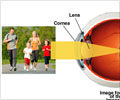Optometrists at Nova Southeastern University (NSU) have found that a combination of in-office therapy and at-home treatment is the best solution for a common childhood eye problem.
Optometrists at Nova Southeastern University (NSU) have found that a combination of in-office therapy and at-home treatment is the best solution for a common childhood eye problem.
The team, led by Stacey Coulter, O.D., worked with researchers across the country to determine which treatment works best for a condition known as convergence insufficiency.Convergence insufficiency, which is common among children, is a condition in which patients cannot accurately point their eyes together, so they see double or have eye strain. Other symptoms of convergence insufficiency include loss of place, loss of concentration, reading slowly, headaches, and blurry vision. It affects some patients’ ability to learn.
“This study has sparked a lot of interest because people are concerned about conditions that can impact learning,” Coulter says.
Traditionally, the majority of eye care professionals treated children diagnosed with convergence insufficiency using some form of home-based therapy. This study concludes that office-based treatment by a trained therapist along with at-home reinforcement is more effective.
The research, reported in the Oct.13 issue of Archives of Ophthalmology, was funded by the National Eye Institute, part of the National Institutes of Health.
The 12-week Convergence Insufficiency Treatment Trial (CITT) study found that approximately 75 percent of those who received in-office therapy by a trained therapist plus at-home treatment reported fewer and less severe symptoms related to reading and other near work.
Advertisement
After 12 weeks of treatment, nearly 75 percent of children who were given the office-based vision therapy along with at-home reinforcement achieved normal vision or had significantly fewer symptoms of convergence insufficiency. Only 43 percent of patients who completed home-based therapy alone showed similar results, as did 33 percent of patients who used home-based pencil push-ups plus computer therapy and 35 percent of patients given a placebo office-based therapy.
Advertisement
RAS/SK












